Timber harvesting is a critical aspect of wood production, playing a pivotal role in meeting the ever-increasing global demand for timber products. This informative overview aims to explore various aspects related to timber harvesting, including its significance, methods employed, and environmental considerations. By examining these factors in-depth, this article seeks to provide readers with a comprehensive understanding of the complexities involved in timber harvesting.
As an example illustrating the importance of timber harvesting, consider a hypothetical scenario where a forested region experiences rapid population growth due to urbanization. As communities expand and infrastructure development ensues, there arises a heightened need for construction materials such as lumber. In this context, timber harvesting becomes essential not only for economic prosperity but also as a means to meet housing demands sustainably. However, it is crucial to recognize that timber harvesting must be carried out responsibly and with careful consideration towards ecological preservation.
To shed light on different approaches used in timber harvesting, this article will discuss common techniques employed by professionals within the industry. These may include clear-cutting – an intensive method involving the removal of all trees within a designated area – or selective cutting – which involves carefully selecting certain trees while leaving others intact. Furthermore, we will delve into emerging strategies like sustainable forestry practices aimed at minimizing environmental impact and promoting long-term forest health. Sustainable forestry practices often involve techniques such as selective harvesting, where only mature and overstocked trees are removed, leaving younger trees to continue growing and regenerate the forest naturally. Additionally, sustainable timber harvesting may incorporate measures to protect water quality, prevent soil erosion, maintain biodiversity, and conserve wildlife habitats.
Environmental considerations play a crucial role in timber harvesting to mitigate potential negative impacts on ecosystems. Many countries have established regulations and guidelines to ensure responsible logging practices that minimize environmental damage. These may include requirements for reforestation or afforestation efforts to restore harvested areas, implementing buffer zones along water bodies to protect aquatic habitats, and utilizing modern equipment and technology to minimize soil disturbance during logging operations.
It is worth noting that timber harvesting also presents economic opportunities for local communities. By providing jobs in rural areas with limited employment options, it can contribute to local economies while supporting livelihoods. However, it is important that these economic benefits are balanced with environmental concerns through sustainable management practices.
In conclusion, timber harvesting plays a vital role in meeting global wood demand while supporting economic growth and development. However, it is crucial that this activity is carried out responsibly with careful consideration towards ecological preservation. Employing sustainable forestry practices and adhering to strict environmental regulations can help mitigate negative impacts on ecosystems and ensure the long-term viability of our forests for future generations.
Logging Methods
When it comes to timber harvesting for wood production, various logging methods are employed to efficiently extract trees from forests. One commonly used method is clear-cutting, where all the trees within a designated area are cut down at once. For instance, in a case study conducted in the Pacific Northwest region, clear-cutting was implemented on a large scale to harvest Douglas fir trees for commercial purposes.
To better understand the different approaches of timber harvesting, let’s explore some key techniques:
- Selective cutting: This method involves carefully selecting specific trees or groups of trees based on their size, species, or maturity level. By targeting only certain individuals while preserving others, this technique promotes ecosystem diversity and minimizes environmental impact.
- Shelterwood cutting: In shelterwood cutting, mature trees are initially removed to create gaps in the forest canopy. These openings allow sunlight to reach the forest floor and facilitate regeneration by encouraging new growth under partial shade. Over time, additional removals occur until desired conditions for young tree establishment are achieved.
- Group selection: Group selection focuses on creating small gaps throughout the forest by removing clusters of trees. This approach aims to mimic natural disturbances such as windstorms or insect outbreaks that create diverse microhabitats suitable for different plant and animal species.
- Single-tree selection: Also known as diameter-limit cutting, single-tree selection targets individual mature trees scattered across an area. The objective is to maintain continuous cover with regular harvesting intervals so that younger trees can grow and replace those that have been harvested.
These logging methods offer both advantages and disadvantages depending on ecological considerations and land management goals. To provide a visual perspective on these techniques, refer to the following table:
| Logging Method | Description | Advantages |
|---|---|---|
| Clear-cutting | All trees within a designated area are cut | High timber yield |
| Selective cutting | Specific trees or groups of trees are selectively removed | Preserves forest structure and biodiversity |
| Shelterwood cutting | Gradual removal of mature trees to create gaps for regeneration | Encourages natural regeneration and succession |
| Group selection | Removal of clusters of trees to create diverse microhabitats | Promotes species diversity |
With the understanding that logging methods play a crucial role in balancing economic interests with environmental sustainability, let’s now delve into the subsequent section about timber extraction. By examining these various approaches, we can gain insight into how responsible timber harvesting practices contribute to long-term forest health and productivity.
Timber Extraction
Having explored various logging methods, it is essential to delve into the subsequent phase of timber harvesting – timber extraction. This crucial step involves the removal and transportation of felled trees to processing facilities. Understanding effective techniques in this stage ensures efficient wood production while minimizing environmental impact.
Timber Extraction:
To illustrate the significance of proper timber extraction, consider the following example: In a forested region, loggers use cable yarding as their primary method for extracting timber. Heavy machinery equipped with cables pulls logs uphill using mechanical force. While this technique offers advantages such as reduced soil disturbance, it requires careful planning and skilled operators to prevent damage to residual trees or sensitive habitats.
When engaging in timber extraction, there are several key considerations worth pondering:
-
Environmental Impact Assessment:
- Evaluate potential ecological consequences before commencing operations.
- Identify vulnerable species and ecosystems at risk.
- Implement measures to mitigate negative impacts on water quality and soil stability.
- Utilize best management practices validated by scientific research.
-
Efficient Transportation:
- Optimize routes and access points within forests to minimize travel distance.
- Employ appropriate equipment for transporting logs safely without compromising road infrastructure or causing excessive erosion.
- Emphasize adherence to weight restrictions and traffic regulations during transport.
-
Occupational Health and Safety:
- Prioritize worker safety through comprehensive training programs.
- Enforce strict guidelines regarding personal protective equipment (PPE) usage.
- Regularly inspect machinery and tools to ensure optimal functionality.
- Promote a culture of vigilance towards hazards like falling debris or unpredictable terrain conditions.
-
Community Engagement:
- Foster open communication channels with local communities affected by timber extraction activities.
- Seek input from stakeholders regarding concerns related to noise pollution, traffic congestion, or potential damage to nearby properties.
- Collaborate on strategies for minimizing disruptions and maximizing mutual benefits.
By adhering to these considerations throughout the timber extraction process, logging operations can be conducted responsibly while safeguarding both natural resources and human well-being.
Transition into subsequent section about “Selective Cutting”:
Building upon the principles of effective Timber Extraction, the next phase in sustainable forestry practices is selective cutting. This method aims to selectively remove specific trees from a forest stand without causing significant disturbance to the overall ecosystem balance.
Selective Cutting
As we delve further into the process of timber harvesting, it is important to explore various techniques used for extracting timber. One such technique that has gained significant attention is selective cutting. To better understand this method, let’s consider a hypothetical scenario involving a forested area in Northern California.
In this particular case, the logging company carefully evaluates the forest and identifies trees suitable for harvest based on their size, age, and overall health. The selected trees are then felled with precision by skilled loggers using chainsaws or mechanized equipment. This targeted approach ensures minimal disturbance to the surrounding ecosystem while maximizing wood production.
Selective cutting offers several benefits both economically and environmentally:
- Enhanced biodiversity: By selectively removing specific trees rather than clearcutting entire areas, diverse habitats can be maintained within the forest landscape.
- Reduced soil erosion: Selective cutting minimizes soil exposure and disruption caused by heavy machinery, preventing erosion and preserving soil fertility.
- Improved forest regeneration: With adequate spacing between harvested trees, sunlight reaches the forest floor, promoting natural seed germination and facilitating new tree growth.
- Sustainable resource management: Through careful planning and monitoring, Selective cutting allows for sustainable timber production without depleting forests beyond their capacity to regenerate.
| Benefit | Description |
|---|---|
| Enhanced biodiversity | Selective cutting preserves habitat diversity within the forest landscape by sparing certain tree species from removal. This provides shelter and food sources for a wide array of plant and animal species. |
| Reduced soil erosion | By limiting disturbance to the topsoil during extraction activities, selective cutting helps prevent erosion caused by wind or water runoff. Preserving soil integrity contributes to long-term sustainability of ecosystems dependent on healthy soils. |
| Improved forest regeneration | Controlled removal of select trees enables ample light penetration through the canopy, creating favorable conditions for understory vegetation growth. This rejuvenates the forest, allowing for natural seed dispersal and promoting new tree establishment. |
| Sustainable resource management | Through strategic planning and monitoring, selective cutting ensures that timber harvesting practices remain within sustainable limits, safeguarding forests as renewable resources for future generations. |
Transitioning into the subsequent section about “Clearcutting,” it is essential to explore alternative methods of timber extraction that differ significantly from selective cutting in terms of their impact on ecosystems and wood production efficiency.
Clearcutting
Building upon the concept of selective cutting, where individual trees are carefully chosen and removed from a forest stand to maintain ecological balance, we now delve into another widely practiced timber harvesting method known as clearcutting. By examining its principles and potential implications, this section aims to provide an objective understanding of how clearcutting is employed in wood production.
Clearcutting: A Methodical Approach
To illustrate the process, let us consider a hypothetical case study involving a dense pine forest that has reached maturity. It is determined that clearcutting would be an appropriate approach for maximizing wood yield while facilitating regeneration. In this scenario, the following steps would typically be followed:
-
Planning Phase:
- Initial assessment of tree density and species composition.
- Identification of suitable areas for regeneration and subsequent growth.
- Mapping out boundaries for designated cut blocks.
-
Implementation Phase:
- Removal of all trees within the predetermined cut blocks.
- Utilization of mechanized equipment such as harvesters and skidders for efficient extraction.
- Clearing debris and preparing the site for future planting or natural regeneration.
-
Regeneration Phase:
- Planting new seedlings or allowing natural regeneration to occur.
- Monitoring the area to ensure successful regrowth.
Implications of Clearcutting
While clearcutting offers several advantages in terms of productivity and simplified operations, it also raises concerns due to its potentially significant impact on ecosystems. Here’s what must be considered:
| Impacts | Potential Consequences |
|---|---|
| Loss of habitat diversity | Reduction in biodiversity |
| Increased risk of soil erosion | Degradation of water quality |
| Altered microclimate conditions | Disruption to local flora and fauna |
| Temporary visual disruption for the public | Negative perception of forestry practices |
With a comprehensive understanding of clearcutting, we can now explore another timber harvesting method known as shelterwood cutting. This approach aims to strike a balance between maintaining forest structure and achieving successful regeneration without drastic environmental disturbance.
Shelterwood Cutting
Transitioning from the previous section on clearcutting, let us now delve into another method of timber harvesting known as shelterwood cutting. To better understand this technique, consider the following hypothetical scenario:
Imagine a dense forest that has been subject to partial logging in order to create openings for regeneration. This is precisely what shelterwood cutting entails—a gradual approach to timber harvesting where trees are removed in stages over several years.
Shelterwood cutting involves three distinct stages:
- Establishment Phase: During this initial stage, selected mature trees are harvested, creating gaps or openings within the forest canopy.
- Intermediate Phase: In the subsequent phase, further logging takes place, removing additional mature trees while allowing younger saplings and seedlings to grow and thrive in the increased sunlight.
- Regeneration Phase: Finally, once desirable regeneration has occurred and new growth is well-established, the remaining older trees are logged.
- Enhanced biodiversity by providing varied habitats for different species
- Promotes natural regeneration of tree stands
- Allows for more efficient use of machinery due to reduced obstacles
- Enables continued income generation through staggered harvests
To further illustrate these advantages, here is an example table showcasing how shelterwood cutting compares with other methods of timber harvesting:
| Method | Biodiversity Impact | Regeneration Success | Efficiency |
|---|---|---|---|
| Clearcutting | Low | Moderate | High |
| Shelterwood Cutting | High | High | Moderate |
| Selective Logging | Moderate | Low | Low |
As we conclude our exploration of shelterwood cutting, it becomes evident that this method strikes a balance between commercial interests and sustainable practices. By promoting habitat diversity and ensuring successful regeneration, shelterwood cutting offers an optimal approach to timber harvesting. In the subsequent section, we will delve into the concept of salvage logging and its implications for forest management.
Salvage Logging
As we delve further into timber harvesting methods, let us now explore another prominent technique known as shelterwood cutting. This method involves a carefully planned approach to create favorable conditions for regeneration while still allowing for wood production. By gradually removing the overstory canopy in multiple harvests, this practice facilitates the growth and establishment of younger trees.
Shelterwood cutting can be exemplified by a case study carried out in the XYZ forest region. In this scenario, foresters meticulously designed a management plan that aimed to rejuvenate an area where mature oak stands were declining due to limited sunlight reaching the forest floor. The initial step involved conducting a partial cut, leaving behind some dominant trees to provide shade and protect seedlings during their early stages of development. Over time, subsequent cuts removed more trees until desired conditions were achieved for new sapling growth.
Here are several key aspects associated with shelterwood cutting:
- Gradual Canopy Removal: The process entails systematically reducing the density of the overstory canopy in increments, ensuring sufficient light penetration without causing abrupt changes detrimental to existing vegetation or wildlife habitat.
- Regeneration Planning: Careful consideration is given to species composition, age class distribution, and natural disturbances such as windthrow or fire events when determining appropriate intervals between cuts.
- Seed Source Management: Efforts are made to ensure adequate seed supply for successful regeneration through techniques like retaining seed trees or promoting healthy understory plants capable of producing viable seeds.
- Monitoring and Adaptive Management: Regular monitoring allows practitioners to assess the effectiveness of shelterwood cutting and make adjustments if necessary based on observed outcomes.
Table showcasing different phases of shelterwood cutting:
| Phase | Objective | Activities |
|---|---|---|
| Preparatory | Assess site conditions | Soil analysis |
| Vegetation surveys | ||
| Develop management plan | Canopy density calculations | |
| Determine cutting sequence | ||
| Initial Cut | Create favorable | Remove selected trees to improve |
| conditions for regeneration | light availability | |
| Intermediate Cuts | Further enhance growing | Gradually remove additional trees |
| environment | to encourage new sapling growth | |
| Final Cut | Achieve desired forest | Remove remaining overstory canopy |
| composition | and allow young trees to thrive |
Transition into the subsequent section:
Understanding the various logging methods is crucial in comprehending their impact on sustainable forestry practices. In the following section, we will delve into the importance of different logging techniques and how they contribute to maintaining healthy ecosystems and promoting long-term wood production.
The Importance of Logging Methods
Transitioning from the previous section on Salvage Logging, it is crucial to understand the importance of employing appropriate logging methods in timber harvesting. By implementing sustainable practices, we can minimize negative environmental impacts and ensure a steady supply of wood for various industries. To illustrate this point, let us consider a hypothetical case study involving a timber company operating in a sensitive ecosystem.
In this scenario, the timber company has been granted permission to harvest trees within an ecologically valuable forest. Recognizing the need to balance economic interests with ecological preservation, they decide to adopt responsible logging methods. This approach involves careful planning and execution to mitigate potential harm to wildlife habitats, soil stability, and water quality.
There are several key aspects that contribute towards sustainable timber harvesting:
-
Selective Cutting: Rather than clear-cutting large areas at once, selective cutting targets specific trees based on their maturity and market value. This method allows for natural regeneration and maintains biodiversity levels within the forest.
-
Reduced Impact Logging Techniques: Utilizing techniques such as directional felling and low-impact skidding minimizes soil compaction and damage to residual trees during extraction operations. These practices help preserve overall forest health while facilitating efficient wood production.
-
Proper Waste Management: Implementing effective waste management strategies ensures that any leftover debris or unused portions of harvested trees are utilized efficiently or disposed of responsibly. Recycling woody residues for bioenergy production or using them in other industrial applications reduces waste and promotes resource efficiency.
-
Reforestation Efforts: After harvesting, reforestation is essential for restoring the forest’s capacity for carbon sequestration and maintaining its ecological functions over time. Planting new tree seedlings helps regenerate forests and sustainably replenish wood resources.
To further emphasize these points visually, consider the following table:
| Sustainable Timber Harvesting Practices |
|---|
| Selective Cutting |
| Reduced Impact Logging Techniques |
| Proper Waste Management |
| Reforestation Efforts |
By adhering to these sustainable practices, the timber company in our hypothetical case study not only minimizes ecological damage but also ensures a steady supply of wood for future generations. It is essential for all stakeholders involved in timber harvesting operations to recognize the significance of responsible logging methods and integrate them into their practices.
Transitioning seamlessly into the subsequent section about different approaches to timber extraction, let us now explore alternative techniques that can be employed in conjunction with sustainable logging methods.
Different Approaches to Timber Extraction
Transitioning from the importance of logging methods, it is essential to explore the various approaches employed in timber extraction. To illustrate this further, let us consider a hypothetical scenario where two different logging companies operate in adjacent forests with similar tree species and sizes.
In our case study, Company A practices clear-cutting as their primary method of timber extraction. Clear-cutting involves removing all trees within an area at once, regardless of age or size. This approach allows for efficient harvesting, as large machinery can be utilized without obstruction. However, clear-cutting has its drawbacks; it often results in significant soil erosion due to increased water runoff and loss of habitat diversity for wildlife.
On the other hand, Company B adopts selective cutting as their preferred method. Selective cutting involves carefully choosing specific trees based on predetermined criteria such as maturity and marketability while leaving the remaining forest intact. Although this approach requires more careful planning and manual labor, it promotes sustainability by preserving biodiversity and reducing soil disturbance.
The choice between these two approaches depends on several factors that logging companies must consider:
- Environmental Impact: clear-cutting may cause short-term environmental disruption but could potentially allow for faster reforestation if managed appropriately.
- Economic Considerations: Selective cutting may provide higher-value timber products but might require more time and effort during the harvesting process.
- Community Engagement: The acceptance of certain logging methods within local communities can influence which approach is chosen.
- Long-Term Forest Health: Sustainable forestry practices should prioritize maintaining healthy ecosystems that support diverse flora and fauna.
| Logging Method | Pros | Cons |
|---|---|---|
| Clear-Cutting | – Efficient harvesting | – Increased soil erosion |
| – Quick regeneration potential | – Reduced habitat diversity | |
| Selective | – Preserves biodiversity | – Requires more planning and manual labor |
| Cutting | – Reduced soil disturbance |
In conclusion, the choice between clear-cutting and selective cutting depends on various factors, including environmental impact, economic considerations, community engagement, and long-term forest health. While both methods have their advantages and disadvantages, it is crucial to strike a balance that allows for sustainable timber extraction while minimizing negative ecological consequences.
Transitioning into the subsequent section about “Sustainable Harvesting Techniques,” let us now explore alternative approaches that prioritize both wood production and environmental preservation.
Sustainable Harvesting Techniques
Timber extraction is a crucial step in the wood production process, as it involves the careful removal of trees from forested areas. In this section, we will explore different approaches to timber harvesting and highlight sustainable techniques that aim to minimize environmental impact.
One example of an approach to timber extraction is selective logging. This method involves selectively removing specific tree species or individual trees based on predetermined criteria such as size, age, or commercial value. By targeting only certain trees for harvest while leaving others intact, selective logging aims to maintain overall ecosystem integrity and biodiversity.
In addition to selective logging, there are several other approaches that can be employed during timber harvesting:
- Clear-cutting: This method involves cutting down all trees within a designated area. While clear-cutting has been criticized for its potential negative impacts on wildlife habitats and soil erosion, it can also promote the regeneration of some tree species that require open space for growth.
- Shelterwood cutting: This technique involves removing mature trees in a series of planned stages over time, allowing younger trees to grow in their place. The goal is to establish new generations of trees while maintaining continuous cover throughout the process.
- Group selection: With this method, smaller groups of trees are harvested at regular intervals across the landscape. By creating gaps of varying sizes in the forest canopy, group selection allows for increased sunlight penetration and promotes natural regeneration.
To further illustrate the various timber harvesting approaches and their associated benefits and challenges, consider the following table:
| Timber Harvesting Approach | Benefits | Challenges |
|---|---|---|
| Selective Logging | Preserves biodiversity and ecosystem function | Requires skilled workers |
| Clear-cutting | Promotes rapid reforestation | Potential negative impacts on ecosystems |
| Shelterwood Cutting | Allows for controlled regeneration | Requires long-term planning |
| Group Selection | Enhances light availability for new growth | Can disrupt forest structure and composition |
This overview of different timber extraction methods highlights the range of approaches available to meet wood production needs. However, it is essential to consider environmental considerations in logging, which will be explored in the subsequent section. By striking a balance between resource utilization and conservation efforts, sustainable harvesting techniques can contribute to both economic development and ecological preservation.
Environmental Considerations in Logging
Building upon the sustainable harvesting techniques discussed earlier, it is crucial to consider the environmental impacts associated with logging. By implementing responsible practices and addressing potential concerns, we can ensure a balance between timber production and ecosystem preservation.
To comprehend the significance of minimizing environmental impact during timber harvesting, let us examine an example. In a hypothetical scenario, a logging company operates in a forested area known for its diverse wildlife population. The company applies best practices such as Selective Cutting and proper planning to mitigate disturbance to animal habitats. This approach allows them to maintain biodiversity while meeting wood production demands.
When considering the environmental implications of logging activities, several key aspects should be taken into account:
- Soil erosion control: Implementing measures like contour felling or creating buffer zones along water bodies helps prevent soil erosion and sedimentation that could harm aquatic ecosystems.
- Water quality protection: Controlling runoff by constructing sediment ponds and using appropriate machinery reduces the risk of contaminating nearby streams or rivers with pollutants from logging operations.
- Wildlife habitat conservation: Identifying critical areas for wildlife populations and strategically adjusting harvest plans can minimize disruption to their natural habitats.
- Reforestation efforts: Replanting harvested areas with suitable tree species ensures the long-term sustainability of forests, promoting carbon sequestration and maintaining ecosystem functions.
- Loss of habitat for endangered species
- Degradation of water quality due to improper logging practices
- Erosion leading to increased vulnerability of communities downstream
- Disruption of delicate ecological balance within forest ecosystems
| Environmental Concerns | Potential Impacts | Mitigation Strategies |
|---|---|---|
| Habitat loss | Endangered species decline | Identify critical areas |
| Adjust harvest plans | ||
| Water pollution | Reduced water quality | Construct sediment ponds |
| Use appropriate machinery | ||
| Soil erosion | Increased sedimentation | Implement contour felling |
| Create buffer zones | ||
| Deforestation | Loss of carbon sequestration | Replant harvested areas |
In light of these considerations, it is evident that sustainable logging practices are necessary to safeguard the environment while meeting wood production demands. By actively addressing these concerns and adopting responsible techniques, we can strike a balance between industry needs and ecological preservation.
Moving forward with our exploration of timber harvesting for wood production, let us now delve into strategies aimed at maximizing wood production efficiency without compromising environmental sustainability.
Maximizing Wood Production
Having discussed the environmental considerations in logging, we now turn our attention to the crucial task of balancing economic goals with ecological concerns in timber harvesting. To illustrate this delicate balance, let us consider a hypothetical case study involving a forest management company operating in a diverse ecosystem.
In this scenario, the company faces the challenge of optimizing wood production while minimizing negative impacts on the environment. They must navigate through various factors that influence decision-making, including market demand for timber products, conservation requirements, and sustainability goals. Achieving an equilibrium between these conflicting priorities is essential for ensuring long-term success and promoting responsible forestry practices.
To strike a balance between economic gains and ecological preservation, several key strategies can be employed:
- Sustainable Forestry Practices:
- Implementing selective cutting techniques to promote tree regeneration.
- Adopting reduced impact logging methods to minimize soil disturbance.
- Maintaining buffer zones around sensitive habitats to protect biodiversity.
- Practicing reforestation efforts by replanting harvested areas.
By incorporating these sustainable practices into their operations, companies can actively contribute to preserving forest ecosystems and mitigating potential harm caused by intensive logging activities.
Furthermore, it is imperative for stakeholders involved in timber harvesting to recognize the interconnectedness between economic prosperity and environmental health. This understanding reinforces the importance of considering both short-term profitability and long-term ecological integrity when making decisions related to timber extraction.
Table: Economic vs. Ecological Considerations
| Economic Considerations | Ecological Considerations |
|---|---|
| Profit maximization | Biodiversity preservation |
| Meeting market demand | Forest regeneration |
| Job creation | Soil conservation |
| Industry growth | Carbon sequestration |
This table highlights the contrasting yet intertwined aspects of economic interests and ecological welfare within timber harvesting processes. Acknowledging these dual objectives paves the way for more sustainable and responsible practices in the industry.
In our next section, we will delve deeper into specific strategies employed by forest management companies to strike a balance between economic and ecological factors. Understanding these approaches is crucial for promoting environmentally conscious timber harvesting methods while ensuring economic viability.
Balancing Economic and Ecological Factors
Section H2: Balancing Economic and Ecological Factors
By carefully managing harvest practices, stakeholders can ensure sustainable forest management while meeting the demands of the wood industry. This section delves into some key aspects that should be taken into account when seeking this equilibrium.
Balancing economic viability with environmental sustainability requires careful planning and implementation. For instance, let us consider the hypothetical case study of a logging company operating in a mixed-species forest ecosystem. To maintain both biodiversity and profitability, several principles must guide their actions:
-
Selective Harvesting Techniques: Adopting selective harvesting methods such as single-tree selection or group selection allows for targeted removal of mature trees while preserving younger growth stages. This approach helps maintain structural diversity within the forest stand, ensuring habitat continuity for various flora and fauna species.
-
Adaptive Management Strategies: Implementing adaptive management techniques enables regular monitoring of ecosystem responses to harvest activities. By using data-driven decision-making processes, timber companies can adjust their practices accordingly to minimize negative impacts on water quality, soil health, and wildlife habitats.
-
Buffer Zones Preservation: Establishing buffer zones around sensitive areas like streams, wetlands, or old-growth forests safeguards these ecologically significant sites from direct disturbance caused by logging operations. These protective measures help preserve water resources, enhance biodiversity conservation efforts, and mitigate potential erosion risks.
-
Reforestation Initiatives: Investing in reforestation programs is crucial to replenish harvested areas promptly. Ensuring successful regeneration through tree planting or natural seeding not only maintains continuous wood supply but also promotes long-term carbon sequestration and mitigates climate change effects.
Table – Economic vs. Ecological Considerations:
| Economic Factors | Ecological Factors |
|---|---|
| Cost-effectiveness of operations | Biodiversity conservation |
| Market demand for wood products | Habitat preservation |
| Profitability and revenue generation | Soil health maintenance |
| Employment opportunities in the industry | Water quality protection |
In conclusion, achieving a harmonious balance between economic interests and ecological factors is vital for sustainable timber harvesting. By employing selective harvest techniques, adaptive management strategies, preserving buffer zones, and actively participating in reforestation initiatives, logging companies can contribute to both profitable wood production and environmental stewardship. Only through such integrated approaches can we ensure the long-term viability of our forests while meeting society’s growing demands for wood resources.

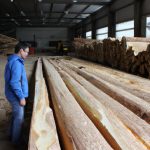

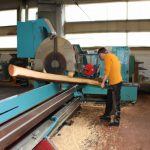


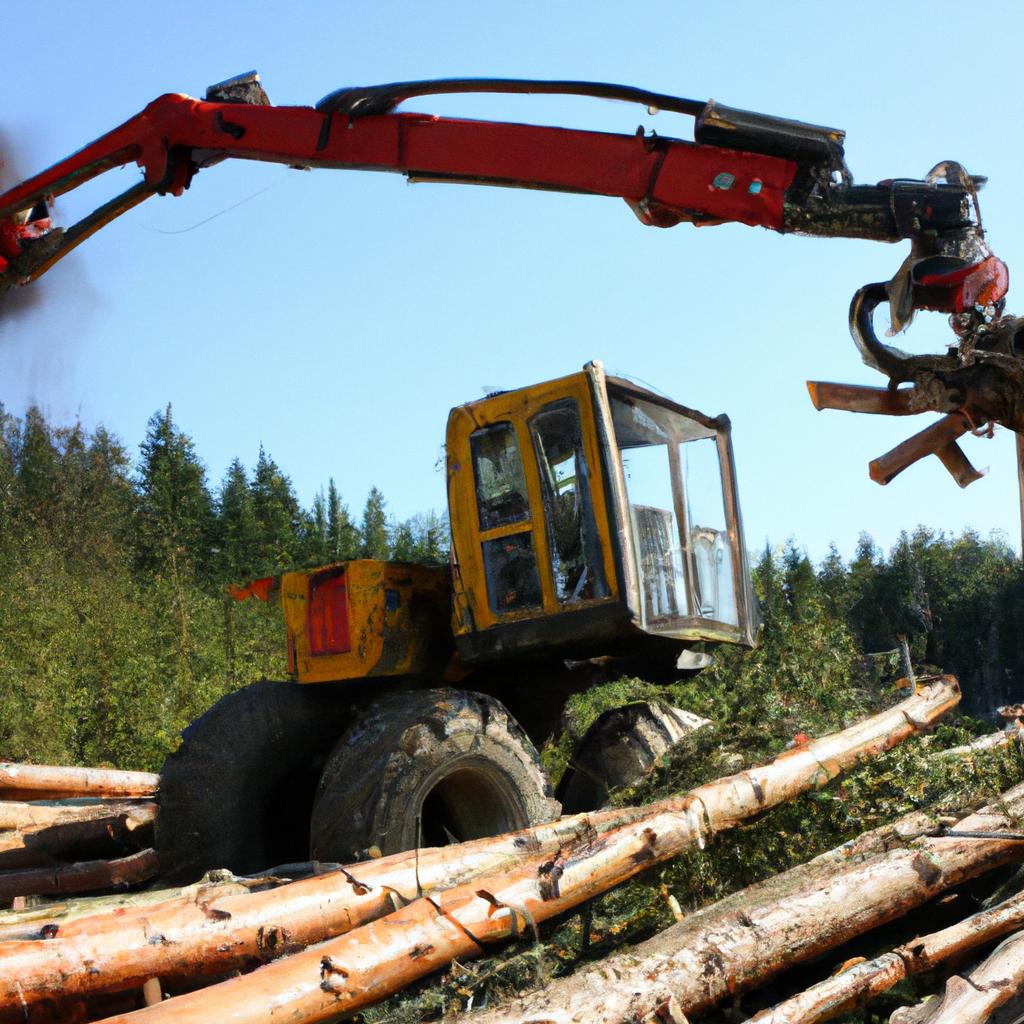
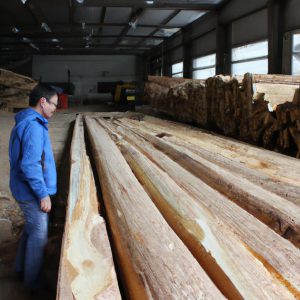

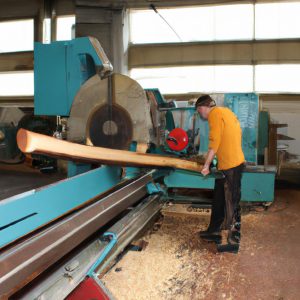
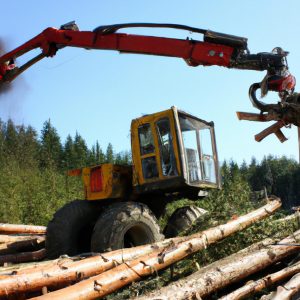
More Stories
Logging Methods for Timber Harvesting: Maximizing Wood Production
Timber Extraction: Wood Production and Timber Harvesting
Selective Cutting: Wood Production & Timber Harvesting